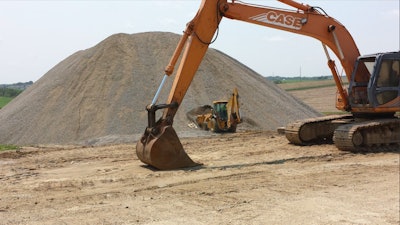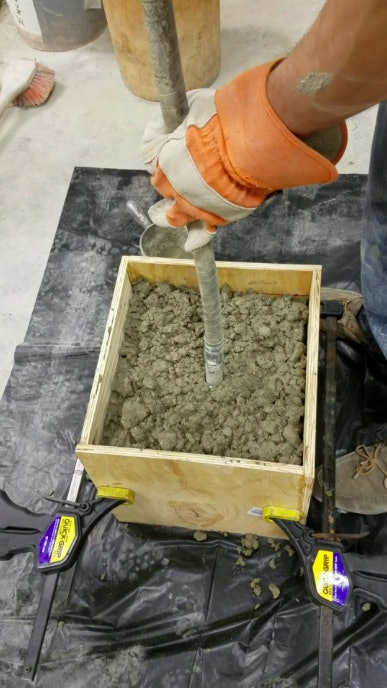
Using recycled pavement as aggregate in new concrete mixes can save money and promote environmental sustainability. New design methods allow engineers to create more durable mixes from recycled aggregate than in the past, reducing the need for virgin aggregate, a diminishing and expensive resource.
“This report shows that a lot can be done with recycled aggregate,” says Matt Zeller, Executive Director, Concrete Paving Association of Minnesota. “We can get the strength up to that of concrete with virgin aggregate by bumping our mix design and lowering our water-to-cement ratio.”
“Concrete pavement made with RCA can be beneficial both economically and environmentally,” says Farhad Reza, Professor, Minnesota State University, Mankato, Department of Mechanical and Civil Engineering.
Reza served as the project’s principal investigator.
What Was the Need?

Newer mechanistic-empirical design methods and performance engineered mixtures have led to improved RCA mixtures. For example, concrete mixtures now have lower water-to-cement ratios. These advances present an opportunity to re-evaluate the use of recycled aggregates in concrete mixes, which aligns with two important trends: the diminishing availability of virgin, high-quality aggregate, and the growing federal emphasis on sustainable design. Using recycled concrete as aggregate fulfills the three basic principles of sustainability: performance, environmental stewardship and cost-effectiveness.
What Was Our Goal?
Researchers sought to evaluate the performance of selected sections of concrete pavement in Minnesota that had been constructed with RCA; examine field samples and lab mixes; and develop guidelines for successful use of recycled aggregate in new concrete pavements.
What Did We Do?
After a literature search on the use of RCA in new concrete pavements, investigators examined the following issues:
- Historical Performance. The research team gathered and compared data on performance, ride quality and durability for 212 miles of RCA pavement and for 212 miles of regular concrete pavement in the state. Both pavement samples had been built in the same time period and had had similar traffic levels.
- Materials and Constructability. Investigators analyzed the ride quality of two-lift (or two-layer) concrete pavement test sections built in 2010 at the MnROAD test facility, using modeling to project long-term performance based on the historical evaluation. They conducted tests on nine cores pulled from the RCA pavements and tested new mixes made with recycled aggregate from Olmsted County, Minnesota. For comparison, they tested virgin aggregates from a Mankato, Minnesota, plant and fines from a Henderson, Minnesota, site.
- Life-Cycle Cost Analysis. The research team conducted a life-cycle cost analysis of new RCA mixes and traditional concrete mixes, comparing their performance and cost-effectiveness.
- RCA Guidelines. Based on the historical analysis, laboratory testing and modeling, and life-cycle cost analysis, the researchers developed new guidelines for the design and construction of pavements containing RCA in concrete mixes.
What Did We Learn?
Results showed that using RCA in concrete pavements can save money and is a sustain-able practice that produces durable concrete pavement.
- Historical Performance. Most of the existing pavement studied had not reached the terminal ride quality index of 2.5—the level that generally indicates a major pavement rehabilitation must be performed. Analysis showed that rehabilitation is required, on average, at about 27 years of service for RCA pavements and at 32 years for standard concrete pavements.
- Materials and Constructability. Mix design can be adjusted to achieve traditional strength levels that older RCA mixes did not reach. Elimination of fines and stricter adherence to gradation specifications for concrete aggregate can achieve workable and durable mixes that are less likely to suffer excess drying shrinkage. Pavements designed in this way meet the standards of the Federal Highway Administration’s INVEST program for sustain-ability in highway construction.
- Life-Cycle Cost Analysis. Long-life RCA pavements are more economical in cost-benefit terms than are thinner, shorter-life RCA pavements.
- RCA Guidelines. Researchers developed specification recommendations and design guidelines for the use of RCA in new pavement construction. Trial mixes are critical, and absorption and compressive strength must be examined before use. Recycled fines are not recommended, but otherwise RCA can be used in the full range of aggregate sizes between minimum and maximum. Recycled concrete pavement may not produce enough aggregate for both pavement and base course, but acquiring extra RCA to make the base course 70 percent recycled and 30 percent virgin makes the new pavement economical and sustainable.
What’s Next?
Keeping detailed records on mix designs used and tracking mix performance over time will help MnDOT to further refine its use of recycled aggregate in concrete mixes and will provide robust data on the performance of more sophisticated RCA mixes. A research team may want to consider using lower-quality recycled concrete as a bottom lift and higher-quality recycled concrete with virgin aggregate in the top lift. Methods for managing water input with recycled aggregate to achieve proper water-to-cement ratios warrant further study.
This Minnesota Department of Transportation Technical Summary pertains to Report 2017-06, “Evaluation of Recycled Aggregates Test Section Performance,” published February 2017.












